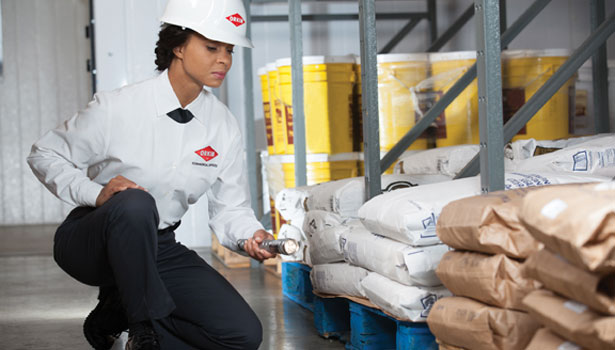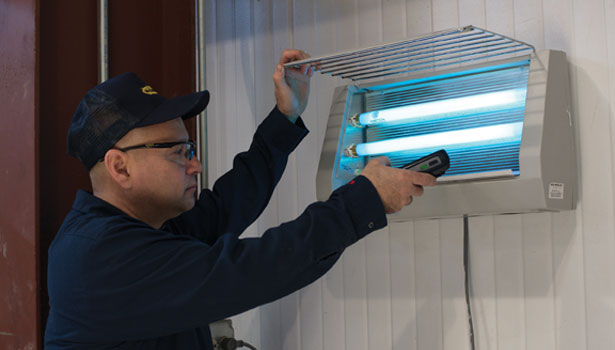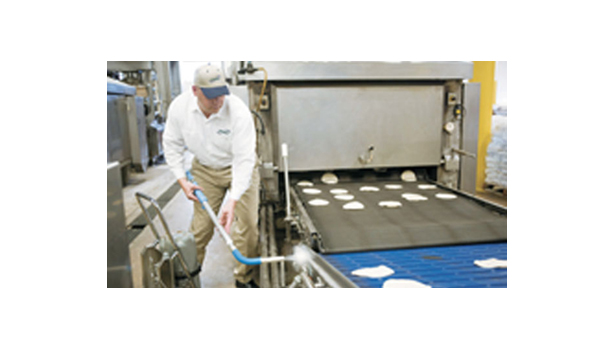Integrated Pest Management
Pest Control: The best defense? A good offense
Integrated pest management protects profits by relying on maintenance and sanitation for pest control, rather than chemical treatments that may require plant downtime.

An effective integrated pest management program means investigating potential sites for pest infestation from production areas to stored product warehousing. Source: Orkin.

Sanitation, exclusion and building maintenance can be combined with fly lights, air curtains, insect growth regulators, pheromone traps and other tools to avoid the need for chemical treatment. Source: McCloud Services.




Stringent hygiene requirements at food and beverage facilities make an effective pest control program imperative. And provisions included in the Food Safety and Modernization Act will require most processors—even those already compliant with independent audit standards like GFSI—to adjust HACCPs and add written controls plans. As a result, integrated pest management (IPM), including inspection, sanitation, exclusion, harborage reduction and the analysis of pest activity, becomes crucial.
New technologies and expertise from leading pest control suppliers can help processors ease the transition to pest management in the food facility of the future. A focus on prevention rather than chemical treatment and environmentally focused methods has helped food and beverage manufacturers keep pests out of production and storage areas.
How can IPM benefit your facility?
The Environmental Protection Agency calls IPM “an environmentally sensitive approach to pest management that relies on a combination of common sense practices.” The program uses information on the lifecycles of pests and the pests’ interaction with the environment, in conjunction with available control methods, to manage pest problems in a targeted yet comprehensive way.
Several components are required to set up a successful IPM program. The first is a comprehensive inspection of your facility for potential structural conditions or sanitation issues conducive to pests. Next, identify current hot spots for pest activity, as well any sanitation or environmental conditions that could create pest problems in the future. Finally, be sure to understand relevant pests’ environmental preferences and lifecycles, since one stage of a lifecycle may be more susceptible to preventative actions.
Building inspection and the identification of current pest activity will help you determine the “point at which pest populations or environmental conditions indicate that pest control action must be taken,” as defined by EPA. Different production environments will necessitate different control protocols. For instance, a bottling or mix room in a beverage facility may require a very low threshold point for fly activity, while a baking facility may have a low threshold point for ants or other crawling insects.
Ongoing monitoring, documentation and staff training also are critical components of your IPM. Ultimately, IPM can improve productivity by relying on maintenance and sanitation for pest control, rather than chemical treatments that may require plant downtime.
Pest control and FSMAThe Food Safety and Modernization Act (FSMA) will require food facilities to include pest control in written food safety plans, similar to the Hazard Analysis and Critical Control Points Plans (HACCPs) for pests already in place in some facilities. For food plants already in compliance with third-party standards such as GFSI or AIB, FSMA’s new requirement shouldn’t mean significant changes. Smaller, regional manufacturers that haven’t yet implemented these rules are likely to be most affected. “We try to model our pest management plans for these facilities after standards by an agency such as AIB and then add any facility-specific requirements to the plan to meet that facility’s needs,” says Stoy Hedges, senior technical professional at Terminix. Hope Bowman, technical specialist at Western Pest Services, recommends consulting a pest control professional to ensure compliance with FSMA and making sure plant personnel are engaged. “The written pest control plan is usually not dependent just on the pest management professional,” says Bowman. “All members of a facility’s team are part of the pest prevention team. “In addition, do not forget to include pest management professionals in your Good Manufacturing Practices training,” she adds. “They need to know what your HACCP plan is as it affects their entry into your plant.” |
An ounce of prevention
It’s no surprise that preventing unwanted critters from entering your facility is the best pest control plan. So, how do birds, rodents and insects get inside?
“Common points of entry include doors, windows, vents, incoming shipments of products being brought into the building or employees, who can bring in pests in lunches or on their personal belongings,” says Patricia Hottel, technical director of McCloud Services. Therefore, maintaining good structural integrity of door seals, windows and vent screens, as well as inspecting incoming goods for pests, are good first steps.
Hottel also recommends educating employees on proper preventive techniques. “Employees should keep doors closed while not in use, for example. Sometimes, an employee will leave the doors open for ventilation purposes or neglect to close a door. Birds, rodents and insects can easily enter the building through this practice.”
Tim Larson, QA manager at Rentokil, says grade-level ramps are the most common entry point in warehousing. He calls high-quality door sweeps the best defense against pest infiltration, though other products can be helpful.
“Expanding foam is a handy ‘hole filler,’ but to use it properly, you must trim off the excess and top the foam with an appropriate sealant,” says Larson. “Steel wool is popular as well, but this will break down over time and is not particularly resistant to chewing rodents. A product made with copper mesh such as Stuff it brand is a better choice.”
Appraising your facility’s surroundings for potential problems also is important. “The pest management professional should inspect the outside of the building for signs of rodents or other pests,” says Hottel. “Rodent control equipment can then be placed around the building’s exterior to control and monitor rodent activity. The data from the equipment and the inspection are then used to determine if any additional control steps are needed.”
Hottel also recommends reducing weed growth and placing a gravel strip or vegetation-free barrier at the building foundation. “Rodents like the comfort vegetation cover can provide, and they feed on plant seeds,” she says.
Facilities should also reduce standing water, which may attract birds or support the lifecycles of aquatic pests like mosquitoes. “Don’t forget sanitation indoors and out, as well as the removal of water sources, excess vegetation and other factors that put pest pressure on structures or allow easy access to facilities,” says Larson.
Entry and forklift doors are another high-risk area. But mechanical technologies, including properly installed air curtains, can reduce the risk of pest infiltration.
“If there’s negative airflow in a building, an air curtain won’t resolve the issue by blowing air across an opening,” Larson warns. “The airflow needs to be slightly positive, and louvers need to be adjusted accordingly. If they’re adjusted inward, nearby flies will get sucked into the plant. So air doors, if not properly installed, can do more harm than good, but they’re a good choice for entry and forklift doors that are frequently used.
“Strip doors aren’t very good at stopping flying insects, but to keep birds out of a facility, they’re an excellent choice. However, there are drawbacks. For instance, some employees tie them off so they don’t have to go through the air door every time they enter or exit. Nothing is perfect, but if used properly, strip doors are a good tool.”
Finally, consider your facility’s exterior lighting. Hope Bowman, a technical specialist with Western Pest Services, says conscientious lighting placement can mitigate the problems associated with flying pests.
“Keep lights off the building to help prevent attracting insects,” she recommends. “For example, instead of putting a light directly above a pedestrian door, install it on a pole away from the building. The insects will then go toward the light and away from the building. It also may be useful to have lights on a motion detector so insects are not constantly attracted to the building. When possible, keeping lights away from potential pest entryways, such as doors or windows, is useful. Sodium vapor lights or white LED lights are also less attractive to insects.” Moving lighting away from facility entrances also can reduce spider populations inside facilities, Bowman adds, as spiders often make their webs near lights to maximize exposure to flying insects.
While it may be tempting to periodically treat your plant’s exterior with chemicals, Larson thinks that’s a shortsighted route. “Chemical barriers are an option, but not a good one,” he says. “The first thing you should do is figure out why pests are close to or coming inside the building. When you spray a material, it will probably work, but a better option is to take care of the sanitation conditions, storage methods or vegetation outdoors that is making that place near the building attractive. If you can handle that, there’s no need to spray a chemical barrier on a frequent basis.”
Starve ‘em out
Exclusion is an important piece of the pest control puzzle, but once inside, pests may be able to complete their lifecycle unless you remove food sources. While the total elimination of food available to pests isn’t always realistic, effective sanitation and waste disposal are critical components of a successful IPM program.
Consequently, food facilities must remove easily accessed or unpackaged food quickly, because the longer food remains onsite, the greater the risk of infestation, states Hottel. “Spills and product accumulations in equipment, racking, beams and floor cracks are more likely insect targets than food in a well-sealed bag,” she says. “Depending on the lifecycle of the pest infesting the product, a long-term accumulation could be defined as one week for flies or six months for stored product pests.”
Wet and dry processing conditions can also affect your facility’s habitability for pests. For instance, larger filth flies need wet organic matter to survive. Regularly removing this kind of material from your facility is important, but leaving it at nearby dumpster compactors can create ideal conditions for these flies, which can then enter a facility through open doors, windows and vents.
Hottel describes what happened at a client’s facility where both bottle flies and house flies were breeding underneath and inside its compactor during the summer months. “When the dumpster was removed, maggots and fly pupal cases were found inside cracks and crevices in the concrete pad,” she recalls. “The cracks and crevices were treated with an insecticide and an insect growth regulator. Ultimately, cleaning the dumpster when it was removed by the trash handling company was required to break the lifecycle. A minor additional charge was incurred, but the simple emptying of the dumpster did not stop the fly lifecycle, and insecticides could not overcome the sanitation issue.”
The best defense is a good offense
An IPM program should emphasize the use of non-chemical methods as a primary solution and low-impact chemicals as a last resort. “Food production, packing and storage facilities are sensitive environments, which means elimination methods must be implemented with a degree of caution,” explains Zia Siddiqi, director of quality systems for Orkin, LLC. “Depending on the type of pest and the severity of the infestation, which establish a critical control point, it’s best to start with non-chemical methods first. These methods—besides sanitation, exclusion and building maintenance—may include fly lights, air curtains, insect growth regulators and pheromone traps. If non-chemical treatments fail, it may be necessary to use low-impact or reduced-risk chemical options.”
For instance, for insects like stored product pests and cockroaches, appropriate solutions may include gel baits, mating disruption treatments, pheromone dispensers or a heat treatment, which requires raising ambient temperatures in certain areas of a facility to levels at which pests cannot survive.
A new treatment using high-dose pheromones to inhibit the successful mating of stored product pests has produced good initial results, according to Hottel. “Currently, it is only available for specific stored product moths in the area of urban pest management,” she says. “But product trials are being conducted for other food industry pests. We have had excellent results in suppressing pests like the Indian meal moth with this technology.”
Ideally, pest management equipment like mouse traps, pheromone lures and light traps would act as monitors for an IPM program, rather than as control devices. “When possible, you should always start with exclusion and sanitation as the means of preventing pest attractants. If these preventive measures are not successful in keeping out pests, non-chemical control measures such as insect light traps can be implemented to monitor and control pests that do enter your facility,” says Siddiqi. “If these measures still are not enough, more extensive treatment may be necessary, such as heat treatment or low-impact chemical solutions. Last, it is critical to have a system to monitor pest activity and analyze the trends frequently to ensure the program is effective.”
If you need to consider chemical treatment, it’s imperative to hire a pesticide applicator licensed by the state where your facility is located. Also, be sure this person adheres to the treatment products’ label recommendations, says Stoy Hodges, board-certified entomologist and senior technical professional at Terminix.
“The choice of pesticide products is based on labels that permit their use around or inside various areas of a food processing facility,” he says. “A wide variety of products have similar language, but the type of pest involved and the location of the infestation help in deciding which of them may be used. The facility and its management also may play a role in deciding which products are ‘approved’ for use in and around a facility.” Following treatment, a pest management professional can help you establish reentry and cleanup procedures.
Every situation is different, but using IPM principles can lead to a quick, lower-cost resolution in most cases. Consider environmental conditions, the characteristics of the pest in question and potential problem spots for pest activity, and you’re well on your way to effective pest management, says Hodges. “I once dealt with a chip manufacturer in the Southeast with beetles inside some areas of its facility, especially the offices and warehouse. Upon inspection, the insects were determined to be various species of water beetles and ground beetles that live and breed in aquatic environments and fields.
“The facility was surrounded by fields in a rural area, with marshy land and waterways not far away. The bright white metal halide lamps used to light the building’s exterior is highly attractive to night flying insects such as these beetles, and was drawing large numbers of them to its exterior every night. Exterior doorways that were opened frequently or had gaps in their weather strips allowed some beetles to enter.
“Once inside, the beetles could crawl or fly to other areas. We recommended changing the metal halide bulbs to sodium vapor lamps which produce a yellow spectrum that is far less attractive to insects. Although insects would still be attracted to the facility, the numbers would greatly be reduced. Weather strips on exterior doors were replaced with tight-fitting strips, and employees were advised to be mindful about how long doors remain open, particularly at night when such insects are most active. By implementing these recommendations, this facility was able to reduce beetle activity to an acceptable level.”
For more information:
Brandon Murphy, McCloud Services, 224-227-6503,
brandonmurphy@mccloudservices.com
David Smothers, Orkin, dsmothers@orkin.com
John Drain, Terminix, 757-560-3273, jdrain@terminix.com
Blair Caswell, Rentokil, 402-554-1942 blair.caswell@rentokilna.com
Billie Carberry, Western Pest Services, 856-308-3886,
bcarberry@westernpest.com
Looking for a reprint of this article?
From high-res PDFs to custom plaques, order your copy today!











